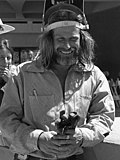History
The Neighborhood
In New York City, from the early 1950s through the mid-1960s (and beyond), many galleries began as an outgrowth of an artistic community that had sprung up in a particular area of downtown Manhattan. The streets between 8th Street and 14th Street between Fifth and Third Avenues attracted many serious painters and sculptors where studio and living space could be found at a relatively inexpensive cost. Author Morgan Falconer describes it this way for the Royal Academy of Art Blog:
[A]rtists lived and worked around them" ... and although "[t]he backdrop was dull – pool rooms, an employment agency, a metal-stamping factory – but the mood lively and do-it-yourself.... One visitor to a group show in 1951 remembered sheltering from the summer heat under a sign painted by Kline.... By day the artists would work, by night they would frequent "The Club", their private talking-shop, or dance in someone's studio – the tango, the jitterbug, even the kazatsky, the Russian folk dance beloved by Communists and Russophiles in the 1930s. [1]
Finding the audience for vanguard contemporary art to be small and the venues in which to show few, artists began to band together to launch and maintain galleries as a solution to the lack of other showing opportunities. Thus began a neighborhood in which several (some now legendary) co-operative galleries were formed, and a few non co-operative galleries as well.
Many of the artists who showed in these galleries, which are often referred to as the 10th Street Co-ops or the 10th Street Scene, have since become well known. Other artists who showed in these galleries are still under known, but in many cases have continued to work with zeal and dedication whether or not they are now famous. Some of the most well-known galleries that made the area what it was were: the Tanager Gallery, The March Gallery, The Hansa Gallery, The Brata Gallery, The James Gallery, The Phoenix Gallery, The Camino Gallery, and the Area Gallery. Although the 10th Street galleries have almost all closed, the Phoenix Gallery remains albeit in a new location and with a new membership. [2]
The Artists
"Approximately 250 artists were dues-paying members of these co-operative galleries between 1952 and 1962. More than 500 artists and possibly close to 1000 artists exhibited on Tenth Street during those years." [3] Several older and more established artists such as Willem de Kooning, Franz Kline and Milton Resnick maintained studios nearby, and often served a supporting role for the many younger artists who gravitated to this scene.
During the most active years of the 10th Street cooperatives, sculptors William King, David Slivka, James Rosati, George Spaventa, Sidney Geist, Israel Levitan, Gabriel Kohn, and Raymond Rocklin, became known as representatives of the 10th Street style of sculpture, even though there was remarkable diversity in their work. [4]
Other galleries associated with the area and the time were the Fleischman Gallery, the Nonagon Gallery, the Reuben Gallery, the Terrain Gallery and the gallery at the Judson Church, which were not co-operatives. [5]
The galleries on and nearby 10th Street played a significant part in the growth of American art and in the diversification of styles that are evident in the art world of today. The 10th Street scene was also a social scene, and openings often happened simultaneously on common opening days. This afforded a way for many artists to mingle with each other and the writers, poets, curators and occasional collectors who gravitated to the scene. The artists and galleries that made up the 10th Street scene were a direct predecessor to the SoHo gallery scene and the more recent Chelsea galleries.
By Photo
(Selection was limited by availability.)
- Sculptor Ronald Bladen, photographed in 1968, was a member of the Brata Gallery.
- Sculptor Mark di Suvero, pictured in 1978, was a member of the March Gallery.
- Artist Budd Hopkins, pictured in 1997, was a member of the March Gallery.
- Painter and performance artist Allan Kaprow was a member of the Hansa Gallery.
- Painter Miriam Laufer, pictured in 1962, is a member of the Phoenix Gallery.
- Painter Emily Mason, photographed in 2016, was a member of the Area Gallery.
- Painter Alice Neel was a member of the Camino Gallery.
- Painter Ray Spillenger was an original member of the March Gallery.
- Multimedia artist Robert Whitman, photographed in 2010, was a member of the Hansa Gallery.
By Representative work
(Selection was limited by availability.)
- The sculpture "Sonar Tide," in front of the Peoria Civic Center is by Ronald Bladen. He was a member of the Brata Gallery.
- The art installation "Narcissus Garden" by Yayoi Kusama is displayed in Brumadinho/Brazil. She was a member of the Brata Gallery.
- Sculptor Richard Stankiewicz created "Miracle in the Scrap Heap," which his now displayed at the Ilana Goor Museum in Jaffa, Israel. He was a member of the Hansa Gallery.
- Frank Stout painted "The Lobster Convention." He was a member of the Tanager Gallery.
- The Sculpture "Negro y blanco horizontalNegro y blanco horizontal" was created between 1993 and 1999 by George Sugarman. It is displayed in Palma de Mallorca, Spain. He was a member of the Brata Gallery.














